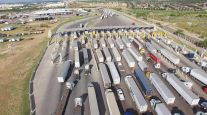U.S. Halts Mexico Border Scheme of Hiding Drugs in Truck Axles
This story appears in the Aug. 26 print edition of Transport Topics.
Motor carriers received a stark reminder earlier this month that cross-border trucking presents special challenges when U.S. prosecutors announced the arrest of 19 members of Mexican drug organizations who allegedly transported drugs in PVC pipes concealed inside tractor-trailer axles.
The arrests, made public Aug. 15 by the U.S. attorney’s office in Los Angeles, came with the claim that cocaine, methamphetamine and heroin were smuggled into the United States using random trucking companies.
The indictments come after a two-year investigation by a Southern California-based federal drug task force. Additional members of drug organizations still may be arrested, officials said.
“The allegations here describe a wide-ranging conspiracy to exploit aspects of our nation’s trucking and transportation system and funnel enormous amounts of dangerous narcotics into this country,” André Birotte Jr., U.S. attorney for the Central District of California, said when the arrests were announced.
The investigation started in 2011 after federal agents began targeting a trafficking organization that transported thousands of pounds of drugs from Mexico via the border crossing in Nogales, Ariz., dropping the contraband off at truck yards in South Gate and Wilmington, Calif.
The PVC pipes containing the drugs were then removed from the trucks and distributed to locations in Arizona and California, including Los Angeles and the counties of Orange, Riverside and San Bernardino, according to the indictment.
“There weren’t any specific trucking companies that were targeted,” said Jay Dauphinais, a Los Angeles-based Drug Enforcement Agency special agent who spoke with Transport Topics. “They were just random.”
No trucking companies were identified in the charging documents.
However, a spokesman in the U.S. attorney’s office in Los Angeles said one of the defendants, Julio Cesar Castro, owned JCC Trucking Inc. The Panorama City, Calif.-based carrier was placed out of service in December for refusing an audit, according to Federal Motor Carrier Safety Administration records.
According to the United Nations Office on Drugs and Crime, cocaine is typically transported from Colombia to Mexico or Central America by sea and then onward by land to the United States and Canada.
U.S. authorities estimate that 90% of the cocaine entering the country crosses the U.S.-Mexico land border,” the U.N. said.
The trucks used for smuggling can so easily be made to look like legitimate operations simply by bearing duplicates of familiar company logos.
Many are the Class 8 vehicles used to cross the border to haul everything from agriculture products to automotive parts. That makes it easy to conceal contraband.
Dauphinais said drivers would pick up a load, giving the traffickers access to the vehicle without their companies’ knowledge.
The drivers may not in some cases have known where or what quantity of drugs was concealed in the truck, but they would likely have been aware that some contraband was on board.
The traffickers would give the truck back to the driver, to be driven across the border, Dauphinais said.
“What the traffickers did was open up the rear axles and put the PVC pipe right into the axles,” Dauphinais said. “There was a capability of storing anywhere from 10 to 16 kilos in the axle.”
More than 2,400 pounds of methamphetamine, 66 pounds of cocaine, 79 pounds of heroin and more than $1.2 million in cash were seized in the course of the two-year investigation, federal officials said.
“What it shows is any part of any vehicle can be used. These guys are always thinking up new ways to smuggle into any kind of vehicle,” Dauphinais said. “But if you crack open the axle, it’s obviously going to hurt the integrity of the truck. It’s probably lucky that the truck makes it across in one piece.”
Added Claude Arnold, special agent at the Los Angeles office of U.S. Immigration and Customs Enforcement: “The criminal networks targeted in this case exploited one of the nation’s busiest transportation corridors to mask the movement of staggering amounts of contraband — the volume of methamphetamine being smuggled by these organizations is virtually unprecedented.”
Dauphinais said the investigation is continuing as agents look into “spin-off information we’ve received since they made the arrests.”




